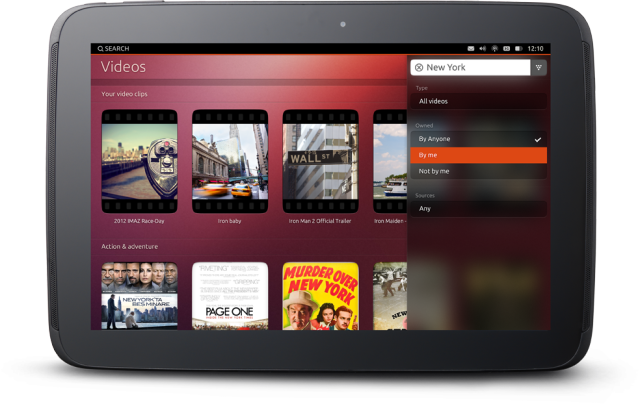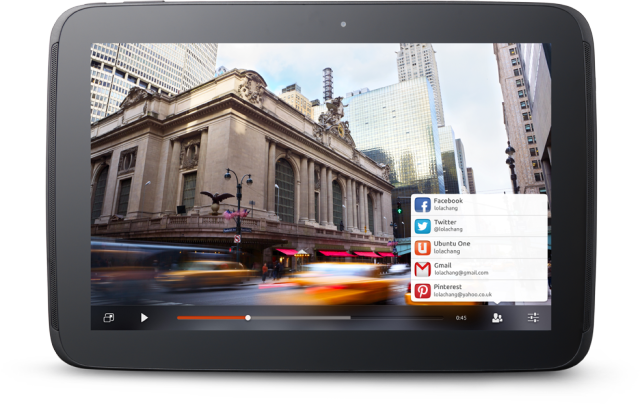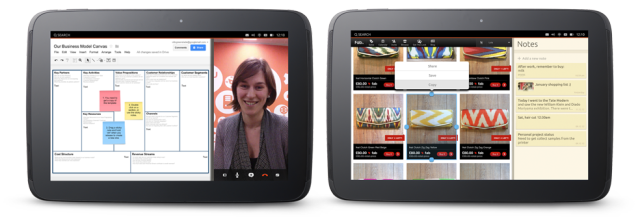A countdown displayed earlier today on the Ubuntu website happened to coincide with an identical countdown from HTC, leading some to speculate that the companies would announce an Ubuntu-based HTC tablet. As it turned out though, the end of HTC’s countdown marked the announcement of the HTC One, and ubuntu.com had their own big announcement.
Just days after Canonical revealed that Ubuntu for phones would be available for testing on the Galaxy Nexus and Nexus 4 later this week, they have given us the first look at the tablet version of their OS. Canonical’s vision is to have Ubuntu seamlessly running on multiple form factors from phones to tablets to televisions, and Ubuntu for Tablets represents the company’s first ambitious foray into a market currently dominated by two competing operating systems.
Ubuntu’s UI has been designed to scale to the appropriate form factor, and Canonical’s video seems to demonstrate a very similar functionality to the ASUS Padfone, whereby a phone docks into a tablet and shared its apps and data with it.
As part of the tablet UI, Canonical have also added a new multitasking pane which they call the “Side Stage”. A swipe from the right edge brings up an area in which a user can run phone apps, as well as any tablet apps that support a phone layout.
If you’re interested in trying out the upcoming tablet version of Ubuntu, developer images will be available for testing on February 21st on the Ubuntu Developer site.
Canonical’s full press release can be seen below:
London 19th February 2013: Canonical today presented Ubuntus tablet interface – the next step towards one unified family of experiences for personal computing on phones, tablets, PCs and TVs.
Multi-tasking productivity meets elegance and rigorous security in our tablet experience, said Mark Shuttleworth, founder of Ubuntu and Canonical. Our family of interfaces now scales across all screens, so your phone can provide tablet, PC and TV experiences when you dock it. That’s unique to Ubuntu and it’s the future of personal computing.
Fashion industry friends say the Ubuntu phone and tablet are the most beautiful interfaces theyve seen for touch said Ivo Weevers, who leads the Canonical design team. Were inspired by the twin goals of style and usability, and working with developers who are motivated to create the best possible experience for friends, family and industry.
The new tablet design doesnt just raise the bar for elegant presentation, it breaks new ground in design and engineering, featuring:
- Real multitasking: Uniquely, Ubuntu allows a phone app on the screen at the same time as a tablet app. The Ubuntu side stage was invented both to enable efficient multitasking and to improve the usability of phone apps on tablets.
- Secure multi-user: Multiple accounts on one tablet with full encryption for personal data, combined with the trusted Ubuntu security model that is widely used in banks, governments and sensitive environments, making it ideal for work and family use.
- Voice controlled HUD productivity: The Heads-Up Display, unique to Ubuntu, makes it fast and easy to do complex things on touch devices, and transforms touch interfaces for rich applications, bringing all the power of the PC to your tablet.
- Edge magic for cleaner apps: Screen edges are used for navigation between apps, settings and controls. That makes for less clutter, more content, and sleeker hardware. No physical or soft buttons are required. Its pure touch elegance.
- Content focus: Media is neatly presented on the customisable home screen, which can search hundreds of sources. Perfect for carriers and content owners that want to highlight their own content, while still providing access to a global catalogue.
- Full convergence: The tablet interface is presented by exactly the same OS and code that provides the phone, PC and TV interfaces, enabling true device convergence. Ubuntu is uniquely designed to scale smoothly across all form factors.
The Ubuntu tablet interface supports screen sizes from 6 to 20 and resolutions from 100 to 450 PPI. The tablet fits perfectly between phone and PC in the Ubuntu family says Oren Horev, lead designer for the Ubuntu tablet experience. Not only do we integrate phone apps in a distinctive way, we shift from tablet to PC very smoothly in convergence devices.
On high end silicon, Ubuntu offers a full PC experience when the tablet is docked to a keyboard, with access to remote Windows applications over standard protocols from Microsoft, Citrix, VMWare and Wyse. An Ubuntu tablet is a secure thin client that can be managed with the same tools as any Ubuntu server or desktop, said Stephane Verdy, who leads enterprise desktop and thin client products at Canonical. We are delighted to support partners on touch and mobile thin clients for the enterprise market.
Even without chipset-specific optimisation, Ubuntu performs beautifully on entry level hardware. Our four-year engagement with ARM has shaped Ubuntu for mobile said Rick Spencer, VP Ubuntu Engineering at Canonical. We benefit from the huge number of contributing developers who run Ubuntu every day, many of whom are moving to touch devices as their primary development environment.
For silicon vendors, Ubuntu is compatible with any Linux-oriented Board Support Package (BSP). This means Ubuntu is easy to enable on most chipset designs that are currently running Android. Ubuntu and Android are the two platforms enabled by Linaro members.
The Touch Developer Preview of Ubuntu will be published on the 21st February 2013 with installation instructions for the Nexus 7 and Nexus 10 tablet devices as well as smartphones such as the Nexus 4 and Galaxy Nexus. Installable images and source code will be available from developer.ubuntu.com.
The Preview SDK, which currently supports phone app development, will now be updated to support tablet apps as well. Uniquely, on Ubuntu, developers can create a single application that works on the phone, tablet, PC and TV because it is the same system and all services work across all form factors.
Visit us at Mobile World Congress: Booth Number: 81D30, App Planet Hall 8.1.
The Canonical team will be available to install Ubuntu on your phones and tablets at Mobile World Congress. Note: Ubuntu Touch Developer Preview is a developer build and not a consumer-ready release.
About Canonical and Ubuntu
Canonical is the company behind Ubuntu and the leading provider of services for Ubuntu deployments in the enterprise. With global teams of developers, support staff and engineering centres, Canonical is uniquely positioned to help partners and customers make the most of Ubuntu. It also operates Ubuntu One, a cross-platform personal cloud service for consumers. Canonical is a privately held company.
Ubuntu is a free, open-source platform for client, server and cloud computing. It is the most widely used Linux on the top 1000 websites by traffic, the reference platform for OpenStack deployments, the most popular guest OS on public clouds, and ships on PCs from Dell, Lenovo, HP and other brands. Since its launch in 2004, it has become the preferred choice for open desktop and scale-out computing, from Fortune 500 companies to hardware makers, content providers, software developers and consumers.








Venture Beat said it’s more elegance than android and more functional than windows phone, what about iOS? where does iOS stand?
I’d like to experiment with it. I use Ubuntu as my desktop OS, largely because of work.
But honestly, Unity is not that great of a desktop UI. It does the job, but it’s not as slick as Windows or MacOS. But it has interesting implications for running in house programs.
And Ubuntu mainly lives on PCs designed for Windows, which are now heavily touch based ultrabooks. Ubuntu has to keep up with this Touch stuff to survive.
So the multitasking is just like Windows Rt